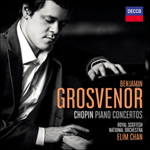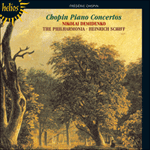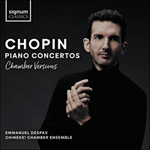
Welcome to Hyperion Records, a British classical label devoted to presenting high-quality recordings of music of all styles and from all periods from the twelfth century to the twenty-first.
Hyperion offers both CDs, and downloads in a number of formats. The site is also available in several languages.
Please use the dropdown buttons to set your preferred options, or use the checkbox to accept the defaults.

The haunting second movement was inspired by Chopin’s infatuation with the soprano Konstancja Gladkowska. ‘Six months have elapsed and I have not yet exchanged a syllable with her of whom I dream every night’, he wrote in 1829, confessing that ‘while my thoughts were with her, I composed the Adagio of my concerto.’ Like the E minor’s Romanza, it is in the spirit of a nocturne, except that it is interrupted by a striking passage accompanied by tremolo strings, a device adopted at a similar point by Moscheles in his G minor Concerto of 1825. A vivacious Hummelesque rondo concludes the work with some imaginative touches, such as the second subject being underscored by the violins playing col legno (i.e. the strings are played with the back of the bow instead of the hair) and the coda introduced by a solo horn proclaiming the key of F major in which the work ends.
from notes by Jeremy Nicholas © 2008
Le lancinant deuxième mouvement fut inspiré par l’engouement de Chopin pour la soprano Konstancja Gladkowska. «Six mois ont passé et je n’ai pas encore échangé une syllabe avec elle, dont je rêve chaque nuit», écrivit-il en 1829, avouant: «pendant que mes pensées étaient avec elle, je composai l’Adagio de mon Concerto». Comme la Romanza du Concerto en mi mineur, ce mouvement est dans l’esprit d’un nocturne, sauf qu’il est interrompu par un saisissant passage accompagné de trémolos de cordes—un procédé que Moscheles avait adopté, à un endroit similaire, dans son Concerto en sol mineur de 1825. Un exubérant rondo hummelesque conclut cette œuvre avec quelques touches inventives, comme la mise en valeur du second sujet par des violons jouant col legno (i.e. avec la baguette de l’archet au lieu de la mèche) et l’introduction de la coda par un cor solo proclamant le ton de fa majeur final.
extrait des notes rédigées par Jeremy Nicholas © 2008
Français: Hypérion
Der bewegende zweite Satz war inspiriert von Chopins tiefer Liebe zu der Sopranistin Konstancja Gl/adkowska. „Sechs Monate sind vergangen, und ich habe noch keine Silbe zu Gesicht bekommen von ihr, von der ich jede Nacht träume“, schrieb er 1829 und bekannte dabei: „Das Adagio meines Konzertes habe ich komponiert, als ich mit meinen Gedanken bei ihr war.“ Wie die Romanza des e-Moll-Konzertes atmet es den Geist eines Nocturnes, das unterbrochen wird von einer eindrucksvollen Passage, untermalt von Streicher-Tremolos, wie sie Moscheles an einer ähnlichen Stelle seines g-Moll-Konzertes von 1825 verwendete. Ein munteres Rondo nach Hummel’scher Art beschließt das Werk mit einigen fantasievollen Einfällen. So fällt das zweite Thema auf durch Violinen, die col legno spielen (d.h. sie berühren die Saiten mit der Rückseite des Bogens statt mit den Haaren); schließlich wird die Coda durch einen Hornruf eingeleitet, der die Tonart F-Dur ankündigt, in welcher das Werk endet.
aus dem Begleittext von Jeremy Nicholas © 2008
Deutsch: Ludwig Madlener
 Chopin: Piano Concertos Chopin: Piano ConcertosBenjamin Grosvenor performs the two Chopin piano concertos with the Royal Scottish National Orchestra and conductor Elim Chan. These are works which played a central role in defining the piano concerto genre for the future, and it's clear from thi ...» More |
 Chopin: Piano Concertos Chopin: Piano Concertos‘In a class of their own. This is great Chopin playing’ (CDReview) 'Demidenko nos propone los dos conciertos … en unas versiones de exquisito lirismo, de ideal trazo orquestal' (CD Compact, Spain)» More |
 Chopin: Piano Concertos Chopin: Piano ConcertosChopin's two piano concertos may have divided opinion at the time of their writing—a case, perhaps, of 'too much, too early'—but they played no small part in defining the genre for the future. Yet for many early listeners, their exposure to them w ...» More |

